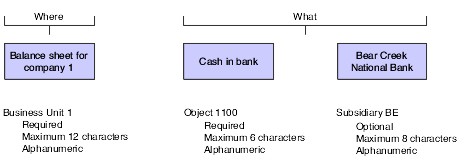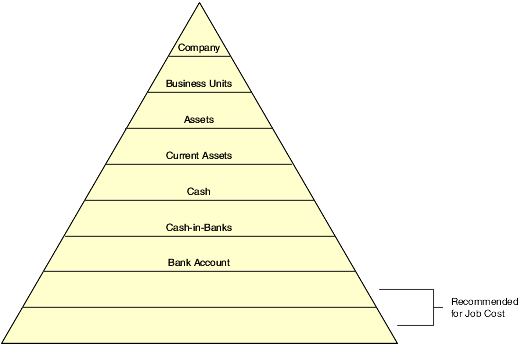6 Understanding the Chart of Accounts
This chapter contains the following topics:
6.1 Business Unit.Object.Subsidiary Format
The JD Edwards EnterpriseOne system uses the business unit.object.subsidiary format for account numbers. You can use periods, commas, or other user-defined symbols to separate the components of the account number. The period (.) separator is the default.
This diagram shows the format requirements:
6.1.1 Business Unit - The Where
The business unit describes where in your organization the transaction will have an impact. It represents the lowest organizational level within your business where you record all revenues, expenses, assets, liabilities, and equities. A business unit can be a department, branch office, truck, and so on.
6.1.2 Object.Subsidiary - The What
The object.subsidiary represents what type of transaction is being created, such as rent or supplies expense and sales revenue. An object is a description of the transaction and a subsidiary is an expanded description of the object account.
These characteristics apply to the object.subsidiary:
-
An object can be up to six alphanumeric characters, depending on your organization's setup
-
A subsidiary is optional and can be up to eight alphanumeric characters (no spaces)
The object, or major, account is required for transaction entry. All object accounts must be the same length. To make data entry easier and faster, you might want to use only numbers for the object account.
The subsidiary, or minor, account is an optional part of the account. Use the subsidiary when you need detailed accounting activity for an object account.
This example shows how you can associate the object account 1110 for Cash in Bank with several subsidiary accounts:
-
1110.BEAR (Bear Creek National Bank)
-
1110.FIB (First Interstate Bank)
-
1110.FRANCE (First Bank of France)
-
1110.LONDON (First Bank of London)
6.2 Chart of Accounts
A chart of accounts provides the structure for your general ledger accounts. It lists specific types of accounts, describes each account, and includes account numbers. A chart of accounts typically lists asset accounts first, followed by liability and capital accounts, and then by revenue and expense accounts.
To design your chart of accounts, begin your initial design with the major headings of your transactions. Then add your detailed transaction descriptions.
This example shows types of accounts and their associated headings:
After you have a complete list of transaction descriptions, you can assign numeric values to each description. Allow for growth and change by leaving spaces in the account structure.
Define the last balance sheet account as the account for year-to-date net income or loss. Balance sheet accounts must precede income statement accounts. For example, if revenues begin at 5000, define object 4999 as the net income account. This account must be a nonposting account. The system calculates the net income amount on your balance sheet.
|
Important: If your balance sheet accounts do not precede your income statement accounts, your financial reports might contain unreliable results. |
You are not limited to one account format when you enter data. An account can have the formats described in this table:
To enter account numbers in a format other than the standard JD Edwards EnterpriseOne format, you must use the prefix character that is defined in general accounting constants.
6.3 Category Codes 21–43
You assign category codes to accounts to expand your reporting capabilities and group your accounts for reporting purposes. You use category codes 21–43 (UDC 09/21–09/43) for accounts in the same way that you use category codes for business units. Unlike category codes 09/01–09/20, these category codes are 10-characters.
The 10-character category codes are useful if your business requires an alternate chart of accounts for statutory reporting. You can use the category code and the description (instead of the account number and description), on trial balance, general ledger, and general journal reports. These category codes let you build summarization logic into your reports.
After you set up values for category codes 21–43, you assign the values to accounts in your chart of accounts. This creates a link between the accounts and the category codes and enables you to print these reports:
-
Debit/Credit T/B by Cat Code (R09472).
-
General Ledger by Category Code (R09470).
You can set up a version for each of the category codes that you use and specify the category code in a processing option for the program.
If you assign the same category code value to more than one of your accounts, the system adds the amounts in all of the accounts and prints the total amount on the report.
The system displays the values for category codes 09/01–09/43 in the Account Cat 1–Account Cat 43 fields on the Work With Accounts form.
6.3.1 Example: Category Code 21
Suppose you want to print a report that shows data from all of your receivable accounts. You decide to use category code 21 (UDC 09/21) for receivable accounts and set up a value REC01 for Notes Receivable, REC02 for Interest Receivable, REC03 for Accounts Receivable, and so on. You assign these values to accounts in your chart of accounts. For example, you assign the value REC01 to category code 21 for each notes receivable account. You can then print selected reports that include all of your receivable accounts.
For this example, you would complete these steps:
-
Set up values for REC01, REC02, and REC03 in UDC table 09/21.
-
Use the Review and Revise Accounts program (P0901) to assign the category code values to accounts in your chart of accounts.
-
For category code 21, assign the value REC01 for notes receivable accounts, REC02 for interest receivable accounts, and so on. To assign a category code, select a notes receivable account on the Work with Accounts form. On the Revise Single Account form, select the Category Codes 21–30 tab and enter REC01 in the Cat Code 25 field.
-
Assign category code values to the remaining accounts in your chart of accounts.
6.4 Level of Detail
You assign a level of detail (LOD) to each account to control how amounts are rolled up, or summarized, into a balance for reporting purposes.
You could set up levels of detail as shown in this example:
Observe these guidelines when assigning a level of detail to an account:
-
Do not skip any levels of detail.
Nonsequential levels of detail can cause errors in financial reports.
-
Assign the level of detail 3 to title accounts for the balance sheet (Assets and Liabilities and Equity).
-
Depending on whether you want the next level of accounts underlined, assign level of detail 3 or 4 to title accounts for the income statement. Title accounts include:
-
Revenues
-
Direct costs
-
General and administrative expenses
-
Other income and expenses
6.5 Posting Edit Codes
Assign a posting edit code to every object or object.subsidiary account in the chart of accounts. This code determines whether the account posts to the general ledger and whether it updates the Account Balances table (F0902).
Posting edit codes exist for these types of accounts:
-
Posting
-
Non-posting (or title)
-
Budget
-
Inactive
-
Machine-generated
-
One that requires units, not monetary amounts.
-
Subledger and type
If you designate an object or object.subsidiary account as posting, the account must be assigned to a posting business unit.
6.6 Differences Between Subledger and Subsidiary Accounting
Subledgers and subsidiary accounting both provide detailed accounting activity. Subsidiary accounts are a subdivision of your object account. Subledgers are linked to your business unit.object account or business unit.object.subsidiary account.
Subledgers give accounting detail without adding accounts to your chart of accounts. For this reason, subledgers are often used for transaction classifications that are not a permanent part of your chart of accounts, such as detailed travel expenses for account representatives.
Subsidiary accounts are permanent. If you want to track revenues and expenses by account representative using subsidiary accounting, you must create a subsidiary account for each account representative and attach it to each appropriate object account for revenues and expenses. This could mean adding several hundred accounts to your chart of accounts.
You can use a subsidiary account and a subledger in the same transaction, if necessary.
These are examples of ways in which subledgers differ from subsidiary accounts:
-
Subledger transactions post to the same major account, rather than to different accounts.
-
Subledgers do not create additional records in the Account Master table (F0901).
-
Subledgers can create additional records in the Account Balances table (F0902), depending on the posting edit code that you assign to the account.
6.6.1 Example: Subledger Accounting
When you use subledgers to track expenses for account representatives, the system creates a record with a unique subledger for each account in the Account Ledger table (F0911). The F0901 table contains only the account, not the subledger.
This example shows the subledgers that represent address book numbers for Smith and Jackson:
| Object (F0901) | Description (F0901) | Object (F0911) | Subledger (F0911) | Subledger Type (F0911) |
|---|---|---|---|---|
| 8665.HOTEL | Hotel | Blank | Blank | Blank |
| 8665.AIR | Air Fare | 8665.AIR | Blank | Blank |
| Blank | Blank | Blank | 1. Smith | A |
| Blank | Blank | Blank | 2. Jackson | A |
| 8667 | Car Expenses | 8667 | Blank | Blank |
| Blank | Blank | Blank | 1. Smith
2. Jackson |
A
A |
6.6.2 Example: Subsidiary Accounting
When you use subsidiaries to track expenses for account representatives, the system creates a record with a blank subledger for each account in the F0911 table. The F0901 table contains an account for each account representative.
| Object (F0901) | Description (F0901) | Object (F0911) | Subledger (F0911) |
|---|---|---|---|
| 8665 | Travel & Entertainment | Blank | Blank |
| 8666 | Air Fare | Blank | Blank |
| 8666.A1 | Account Representative 1 | 8666.A1 | Blank |
| 8666.A2 | Account Representative 2 | 8666.A2 | Blank |
| 8667 | Car Expense | Blank | Blank |
| 8667.C1 | Account Representative 1 | 8667.C1 | Blank |
| 8667.C2 | Account Representative 2 | 8667.C2 | Blank |

